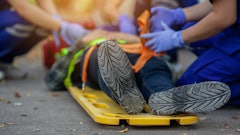A recent study by Texas A&M University's Texas Transportation Institute (TTI) provides the most compelling evidence yet that wider paint lines on roadway shoulders (commonly called edge lines) are a cost-effective, statistically-sound approach to reducing crashes and fatalities on rural two-lane highways. The study, entitled "An Evaluation of the Effectiveness of Wider Edge Line Pavement Markings," was sponsored by the American Glass Bead Manufacturers' Association.
"This is the first formal evidence of a correlation between wider edge lines and improved crash safety," said Paul Carlson, Ph.D., a TTI research engineer and one of the authors of the study. "Previous studies over the last 10 years were small, naive in analyses and lacked data to provide statistically significant results."
In the past, many states adopted wider edge lines (six inches instead of four inches) for a range of reasons, but adoption has been slow and uncoordinated without sound empirical findings to support the decision, according to the study. Glass bead products are frequently used for highway safety markings such as these, providing the light-reflective lane markings found on highways around the world. Previous studies found indirect evidence to support wider edge lines, but evidence showing direct reduction in crashes was difficult to provide due to data issues, the study noted. The recent analysis of Federal Highway Administration data from three states (Kansas, Michigan and Illinois) provides the necessary evidence to support adoption of wider edge lines, the study asserts.
"With the ultimate goal being highway safety, transportation agencies across the U.S. now have strong data to support the undertaking of a relatively low-cost measure to improve highway safety and reduce fatalities," said Kevin Goforth, president of the American Glass Bead Manufacturers' Association.
The study demonstrated that wider edge lines have been shown to reduce total crashes 15 to 30 percent, and fatal plus injury crashes 15 to 38 percent. In addition, the benefit-cost ratio for wider edge lines is $33 to $55 for each $1 spent, which is similar to shoulder rumble strips. If an agency is considering installing rumble strips as a safety counter measure but concerned about potential noise or pushback from the bicycle community, wider edge lines appear to offer similar results but without the concerns, according to the report.
The study suggests since the safety benefits of wider edge lines are now better documented, it would be beneficial if the Manual on Uniform Traffic Control Devices, or MUTCD, was amended so that minimum edge line width on rural two-lane highways was six inches. Agencies would then be able to implement the policy in a uniform and consistent manner, the study concludes.
The Texas Transportation Institute, located in College Station, Texas, is an agency of the Texas A&M University system.


















